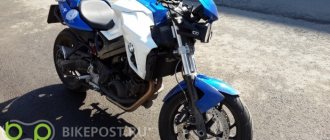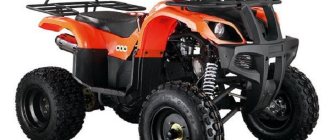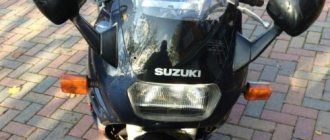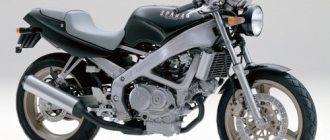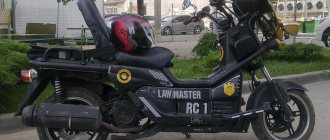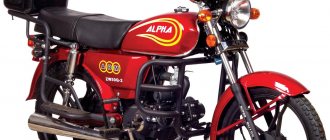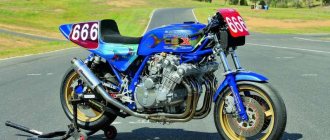Honda CX500
Almost immediately after its introduction, the Honda CX500 was ridiculed: it was given unkind nicknames, and after the price was reduced, this model became popular among two-wheeled couriers. But the engine, created by motorsport legend Shoichiro Irimajiri, inevitably attracts the interest of a new generation of customizers who are happy to breathe new life into this model.
A little-known fact: in some markets this model was produced in a sports version, significantly improved, but rather late. Now, 40 years later, the Bulgarian masters under the Tossa R brand, using their experience in motorsports, have released their own vision of what the sports version of the CX500 should look like.
MY MOTORCYCLE
The Honda CX500 is an almost unique motorcycle, primarily because it was equipped with a turbine as standard. Yes, yes, this is a turbocharged racing bike. This bike with a longitudinal V-twin with a volume of 497 cubic centimeters has a 4.5-centimeter turbine capable of spinning up to two hundred thousand revolutions per minute. The Nonda CX500 TC was first released in 1982. Motorcycles with turbines were then being developed by all Japanese motorcycle manufacturers - Yamaha, Kawasaki, Suzuki, but Honda managed to release the CX500 to the market first. The motorcycle turned out, of course, ambiguous. In addition, the above companies installed turbines on in-line engines, while Honda used a V-twin.
The result of turbocharging was high power in the upper rev range, and the 500cc CX500 rode on par with larger sportbikes. But due to the same turbine in the lower range, the engine produced quite little power and torque, and was also characterized by “jerky” and uneven operation.
Unfortunately, the Honda CX500 was not very popular. First of all, this was due to the considerable price that had to be paid for such an unusual motorcycle, but at the same time, sportbikes with 750 cc engines (750 cc - a very common cubic capacity for Japanese motorcycles of the 80s) rode no worse, and cost significantly cheaper.
In addition, the operation of the turbine on the CX500 caused certain complaints. By its design, the turbocharging was not bad, but the turbine took some time to “spin up”, and therefore the response to turning the throttle was slightly slow. To put it simply, first the motorcycle pilot unscrewed the handle, then for half a second nothing happened, after which he seemed to get a kick from behind, and the bike shot forward.
Due to this feature and obvious focus on track driving, the turbocharged Honda did not gain significant popularity and soon left the scene, losing the battle to conventional naturally aspirated engines. But to this day there are many fans who actively scour auctions and look for a CX500 in good condition. This is not a trivial task, given the age of the motorcycle, but due to its unusual nature, this model is popular among customizers, in particular among fans of cafe racer-style motorcycles.
Review of the Honda CX500 Turbo (CX500TC) motorcycle
Honda CX500 Turbo sports tourer model
was officially introduced in 1981 (1982 model year) primarily for the North American and West German export markets. The model was built on the basic version of the Honda CX500, but featured advanced front wind protection, electronic fuel injection and a turbine. The Honda CX500 Turbo was the first production Honda motorcycle with programmable fuel injection and a turbocharger, the use of which increased the maximum power from 50 to 82 hp compared to the basic version.
Another important feature of the Honda CX500 Turbo, as well as the entire CX500 line, was a 2-cylinder V-shaped liquid-cooled engine, located longitudinally in the frame (as on Moto Guzzi motorcycles), with a cylinder camber angle of 80°. It is also noteworthy that at first the longitudinally located V-shaped (90°) engine, when tested by pilots, turned out to be extremely uncomfortable ergonomically (the legs rested on the carburetors) - to solve this problem, the engineers had to reduce the cylinder camber to 80° and turn the cylinder heads to 22° relative to the cylinder axis. The engine is equipped with 4 valves per cylinder and a lower camshaft. Also, unlike the basic version, the Honda CX500 Turbo model received a reinforced clutch and gearbox.
Other features of the Honda CX500 Turbo include a steel frame, pneumatically adjustable suspension (the front fork has an anti-dive system TRAC - Torque Reactive Anti-dive Control), disc brakes, a 20-liter fuel tank, a 5-speed gearbox and a 260 kg curb weight.
1982 was the last year of production of the Honda CX500 Turbo, after which it was replaced by the new Honda CX650 Turbo, which, however, also lasted only one year.
Turbocharged motorcycle models from other Japanese manufacturers:
Content
Brief history of the model
- 1981 (1982 model year) - the first and only year of production of the model.
Model:
Honda CX500 Turbo (North America, West Germany).
Factory designation:
CX500TC.
Power transmission [edit]
Engine[edit]
The CX series has a crankshaft configuration longitudinally aligned with the bike's axis, similar to the Moto Guzzi layout. Unlike the flat-twin "boxer", the cylinders protrude at an angle above the horizon. The CX's rake angle is 80° and the heads are angled 22° so the air intakes don't interfere with the rider's legs. The camshaft is pressed against the base of the V between the cylinders. Although Honda generally favors overhead cylinder engines, the rotation of the cylinder head required the use of short pushrods to operate the four overhead valves per cylinder, with a rocker fork acting on each pushrod. The 5-speed transmission is located under the crankshaft, with both in the same housing, keeping the engine short (in length) but quite tall. The engine has a compression ratio of 10.0:1 and a redline of 9,650 rpm. As with the Honda Gold Wing, the transmission rotates counter to the engine's rotation to help counteract the tendency of engine torque to lean the bike slightly to one side when opening or closing the throttle.
The CX was the first V-twin motorcycle Honda ever built. It was originally designed as a 90° V-twin. Honda built a prototype of the CX350, but it was never released to the public. In this version the cylinder heads had no cylinder head torsion. [3]
Transfer[edit]
Final drive with shaft. Power is transmitted by an enclosed splined driveshaft with a single universal joint. The shaft drives a bevel gear, to which the wheel is connected by a shock absorber that absorbs and dampens the shock and vibration of the drivetrain. The bevel drive rotates in an oil bath and a grease nipple is provided to lubricate the shaft bearing.
Wheels[edit]
These ComStar wheels combine the flexibility of wheels with the spoke strength and tubeless characteristics of solid wheels. Honda had introduced Com-Star wheels a year earlier on the CB250T/400T Dream, as well as the CB750F2 and GL1000 Gold Wing, although these had stock rims that required the use of inner tubes. The CX500 was the first production motorcycle to use tubeless tires. [4]
Motorcycle Honda CX 500
CX 500 - This is a sports motorcycle that was produced in the last century and has earned recognition from motorcyclists for its unique qualities.
A distinctive feature of the model is that the manufacturer installed a turbine on its V-shaped twin.
For whom
Here are the advantages of the Honda CX 500:
- ease of use;
- comfort of landing;
- a kind of uniqueness in constructive terms.
The model is perfect for connoisseurs of those sports motorcycles that have already gone down in history as outstanding. The bike is an interesting piece for a motorcycle collector, since its design and production time allow it to be called a rarity.
Specifications
In terms of its parameters, this is a very powerful motorcycle for its time, which can surprise even the most experienced rider of our days. But because of the turbine, the car cannot show as good performance at lower speeds as at higher speeds. In addition, these design features lead to uneven, “jerky” engine operation.
Engine
The Honda CX 500 has a specific engine that cannot be called ideal either within the class or in motorcycle practice in general. Of course, the turbine is to blame, it was installed not just anywhere, but directly on a four-stroke, V-shaped, two-cylinder unit with a volume of 497 cm³. The maximum torque here is 46 Nm, and the power is 50 hp.
Transmission
The CX 500 uses a cardan as a drive. The gearbox here is five-speed. This transmission is enough for the motorcycle to confidently realize the potential of its engine, even if a little power is lost when transferring to the rear wheel.
Dimensions and weight
A wheelbase of 1455 mm and a seat height of 820 mm indicate the rather large dimensions of this machine. The motorcycle reaches 2205 mm in length, 770 mm in width, and 1205 mm in height. Together with fuel, the motorcycle weighs 225 kg, and its tank volume is 19 liters. On average, the model consumes about 6 liters of gasoline per 100 km.
Chassis and brakes
The CX 500 features a steel frame that matches the typical sports bike look of the era. The colors were also well chosen, using bright shades against a general off-white background. Alloy wheels and a classic steering wheel for the class successfully complete the picture.
The rear of the bike has a pendulum suspension, which is equipped with two shock absorbers. At the front there is a telescopic fork measuring 39 mm. The rear brake is a drum version, and at the front there is a pair of discs, each 275 mm, complete with two-piston calipers.
Production
The CX 500 was produced from 1977 to 1986. It never gained much popularity, because at that time it was much more rational to buy another sports bike, which was cheaper, gave no less performance, and, moreover, did not have a complex character.
Classmates
Since this car is a very specific model, it has no competitors as such. There are motorcycles that are similar in performance and appearance, but they either do not have a turbine, or the engine is inline rather than V-twin, which makes these bikes very different from the CX 500.
History of changes
During her career, the model went through certain stages of development:
- 1977 – start of production;
- 1979 – second generation;
- 1986 – end of production.
The CX 500 is a good motorcycle, very original, but precisely because of this it did not become an exemplary representative of the class of its era.
Options [edit]
CX500[edit]
1979 Honda CX500
The 1978 CX500 Standard had a large fuel tank, stepped seat, round brake fluid reservoir, and a plastic mini fairing that was considered unusual at the time. The turn signals run through the mini fairing from the centerline of the headlight. The CX500 Standard had silver Comstar wheels, 19" front and 18" rear. [ clarification needed
]
While V-twins were nothing new, as Moto Guzzi had mounted them with the crankshaft in-line with a shaft-drive frame for many years, this Honda was decidedly different. 497 cc engine Not only was the CM water-cooled, but it had four valves per cylinder, which were actuated by pushrods rather than the overhead camshafts that Honda had favored in its previous four-stroke engines. [5]
The modeling was radical[ edit]
] and the vertical forks and short engine contributed to a Stubby wheelbase on a bicycle that was quite tall.
The CX500 was one of the first recipients of Honda's new Comstar wheels (and later, on B models, reverse Comstar and square brake fluid reservoir), which measured 480 mm (19 in) at the front and 16 in (410 mm) at the rear. back. [ citation needed
]
The fuel tank tapered towards the front and a huge crescent of light tail protruded from the short fairing behind the radically stepped seat. The end result is a combination of standard, sport and cruise features.
CX500 Custom [edit]
Honda CX500C custom
Honda CX 500 C
The "Custom" variant, introduced in 1979, had a smaller, narrower tank and antler-shaped handlebars. The headlight and gauges were similar to the CX500 Deluxe. The turn signals were now mounted along the fork tubes, below the level of the headlights. 1982 was the final model year for the CX500. In 1983 it was increased to 673 cc. See and became the CX650. The CX650 had different styling and the engine was painted black instead of plain aluminum.
CX500 Deluxe[edit]
The Deluxe model appeared in 1979. This bike looked almost identical to the original CX500 Standard, minus the regular (85 mph) gauges and headlights (the mini fairing was deleted) and the black inverted Com Star wheels - 19" front and 16" rear. 1981 was the final year for the CX500 Deluxe model.
The CX500 was a great success. It proved to be reliable and economical, being the cheapest gimbal bike available. Many examples still exist today and, together with the GL Silverwings, are quickly becoming iconic bikes. There are owners' clubs all over Europe and the world.
CX500EC Sports[edit]
1985 Honda CX500 Sports
Introduced in 1982, the EC variant is a vastly improved motorcycle over the original 500. As is the CX500 Turbo introduced in the same model year, the Sport (after the release of the CX650ED 'Eurosports' was also referred to by many people as the CX500EC). as "Eurosports", although technically incorrect) has a front fork with pneumatic preload and an anti-dive mechanism known as TRAC (Torque Reactive Anti-Dive Control), and rear suspension with a Prolink monoshock with pneumatic preload. . The wheels have also been modified with an upgraded Comstar with 18 in (460 mm) round holes and a 100–90H18 front tire and 120–80H18 rear tire. The brakes are significantly improved with much more efficient dual-pot calipers at the front and a new disc brake with a dual-pot caliper at the rear replacing the original drum. The Sports has also received significant restyling with larger fuel tank, nose cone, side panels, seat and tail that have much more modern lines. Only two color options were made in the UK: white pearl with blue and red stripes, or black with orange and silver stripes. The instrumentation has been improved with the introduction of a fuel gauge and, like the rest of the bike, the appearance has been significantly updated. Plastic mud flaps replace the chromed steel versions on earlier cars, eliminating associated rust problems. The round headlight of early motorcycles is also replaced by a rectangular lens that provides improved night illumination. Pearl white with blue and red stripes or black with orange and silver stripes. The instrumentation has been improved with the introduction of a fuel gauge and, like the rest of the bike, the appearance has been significantly updated. Plastic mud flaps replace the chromed steel versions on earlier cars, eliminating associated rust problems. The round headlight of early motorcycles is also replaced by a rectangular lens that provides improved night illumination. Pearl white with blue and red stripes or black with orange and silver stripes. The instrumentation has been improved with the introduction of a fuel gauge and, like the rest of the bike, the appearance has been significantly updated. Plastic mud flaps replace the chromed steel versions on earlier cars, eliminating associated rust problems. The round headlight of early motorcycles is also replaced by a rectangular lens that provides improved night illumination.
The changes extended to the engine, where Honda's late 1970s cam chain problems were solved by introducing an automatic tensioner, replacing the manual version on earlier models. Other changes also meant that standard valve clearances were reduced, possibly due to tighter manufacturing controls. Sports model engines can be identified by the absence of a cam chain tensioner bolt and updated valve covers with black stripes and satin alloy flats.
These changes made the 500 Sports significantly better in both appearance and handling, and also made it more reliable than previous versions.
The later CX650ED shared most of the cosmetic changes made by the 500EC, while a 400cc version was introduced in Japan. See with the same style in accordance with the licensing rules. GL500 / GL650 Silver wing
| Manufacturer | Honda |
| Production | 1981-1982 (GL500) 1983 (GL650) |
| Class | Touring motorcycle |
| Engine | OHV, liquid-cooled V-twin engine, 497 cc cm (GL500), 674 cc CM (GL650) |
| Maximum speed | 180 km/h (110 mph) [6] |
| Power | 37 kW (50 hp) (claimed) [7] [6] (GL500) 48 kW (64 hp) (claimed) [7] (GL650) |
| Transmission of infection | 5-speed manual transmission, driveshaft |
| Suspense | Front: Air-adjustable fork Rear: Pro-Link |
| Brakes | Double front disc |
| Wheelbase | 1496 mm (58.9 in) |
| Seat height | 775 mm (30.5 in) |
| Weight | 217 kg (478 lb) (dry) 242 kg (534 lb) [6] (wet) |
| Fuel tank capacity | 17.5 L (4.6 US gal) |
GL500 Silver Wing and GL650 Silver Wing[edit]
Not to be confused with Honda Silver Wing (scooter).
In 1981, Honda released the GL500 Silver Wing, a mid-size touring motorcycle based on the CX500 engine. The GL500 engine was similar to the CX500 engine, but used a more robust transistorized ignition system, meaning the stator would only contain charge windings and thus provide more power to drive lights and other devices typically added to touring motorcycles. The GL500 also used Honda's Pro-Link monoshock rear suspension and was available as either a naked bike or a faired Interstate model. The Interstate included a large factory fairing, hard saddlebags and rack. This made the Silver Wing look like a miniature Gold Wing GL1100 Interstate. The 1981 model had a small tail rack, which was replaced with a larger rack in 1982. The rack was interchangeable with the rear seat - the bike was designed only for a rider with the rack installed, although there was a spare extension to allow the rack to be fitted. installed behind the passenger seat.
In 1983, the GL500 was upgraded to the GL650. In addition to the larger engine, the GL650 had slightly different fairing mounts and front engine mount than the GL500, and the GL650's engine parts were painted black. The GL650's fuel economy has been improved over the GL500 thanks to significantly higher gearing and the replacement of the CX/GL500's mechanical radiator fan with an electric fan.
CX-based Silver Wings were discontinued after the 1983 model year. [8] Due to overproduction of the 1982 GL500, some were not sold new until 1984.
CX500 Turbo[edit]
Honda CX500 Turbo in the Honda collection hall
1983 Honda CX650 Turbo on display at Barber Vintage Motorsports Museum
The CX500 Turbo was released in 1982. The CX500 Turbo (also known as the CX500TC) was produced for the 1982 model year only. It was replaced for the 1983 model year by the CX650TD (CX650 Turbo; D=1983), which was discontinued that same year. The 1982 CX500T was Honda's first production motorcycle to feature programmed fuel injection. [9] With redundant fail-safe systems operating in tandem with a separate ignition system. Electronic system failures were reported to the driver via two dashboard displays: a problem with the fuel injection system would be illuminated by the "FUEL SYSTEM" indicator on the instrument panel, and an ignition problem would be indicated by a flashing "TURBO" indicator.
Due to the technological uniqueness of motorcycles, many bikes have been sold to professional motorcycle maintenance schools for practical training. [ verification required
]
The CX500TC's powerplant was based on the water-cooled, four-overhead-valve, pushrod-per-cylinder, V-twin engine found in the CX500 introduced a few years earlier. The appearance of the engine compartment remains virtually unchanged from the original CX500. The turbocharger, at maximum boost, delivering approximately 19 psi of boost, nearly doubles the engine's power output. The engine crankcase is modified to accept the larger crankshaft bearings of the CX650 released the same year, while the suspension, brakes, frame and fairing are significantly different from the earlier CX500, as well as the Pro-Link and TRAC (Torque) rear suspension Reactive Anti-dive Control) were used on the CX500EC (released in 1982) and CX650ED (released in 1983).
CX650C[edit]
1983 Honda CX650C
The CX650 Custom is a one-year model released in 1983 for the US market. Like other CX customs, especially the CX400C designed for the Asia-Pacific region, this model was a cruiser. The frame is completely different and the styling was sold to satisfy the American desire for the low-slung look of American cruiser bikes. Its half-chopped forks, tear tank, low seat and cropped exhaust gave it a very rakish look. However, it was very similar in style and price to the 750 Shadow, and Honda decided to only have one cruiser bike in this class, which was the reason for its short lifespan.
CX650ED[edit]
Honda CX650E
The CX650ED or Eurosport was also introduced in 1983 and was very similar in appearance to the CX500EC Sports launched the previous year. It was aimed at the UK, European, Canadian and Australian markets. Brakes, suspension and handling have been improved over CX500 variants. The model has many similarities with the CX500TC. Tubular frame construction, TRAC anti-dive forks, Pro-Link rear suspension, dual pot brakes, and front and rear discs. Although this model was not sold in the United States, several were imported by private owners.
CX650T[edit]
For the 1983 model year, the CX500 Turbo's engine capacity was increased to 673 cc. See, along with the increase in power. In addition to the increase in displacement, the compression ratio was increased and maximum boost pressure was reduced, providing a smoother transition from naturally aspirated to on boost. The fuel injection control system has been significantly redesigned for the CX650 Turbo, and the rear shock has also received an update, adding a manually controlled damping control mechanism to complement the previous model's "air" preload.
Cosmetically, the CX650 Turbo differs little from its predecessor other than the colors and badging. However, in an effort to cut costs, Honda made the 650 Turbo's fairing from ABS plastic, as opposed to the 500 Turbo's fiberglass fairing. Honda built 1,777 models, of which less than 1,200 were imported into the United States and Canada. Only 100 units were shipped to the UK and none were exported to Australia. [10] [11]
In the fall of 1982, Honda intended to make the new CX650T available to every American Honda dealership for sale. Sales were low due to the high retail cost of the bikes and expensive insurance. At the end of the year, dealerships located in the Midwest began shipping unsold bikes to California, where the bike was more popular and could sell.
Other options[edit]
Honda CX Euro 400
In the Japanese and European markets, 400cc versions of the CX and GL appeared, aptly named CX400 and GL400. In Japan, the GL650 SilverWing Interstate was released as the Limited Edition GL700 Wing Interstate, although it used the same 674 cc engine. See which was used in the GL650. Also in Australia, the "standard" 1980–1982 CX500 models were known as the "CX500 Shadow".
Review of the Honda CX500 motorcycle
Brief description and competitors of the Honda CX500
Honda CX500 road bike model
appeared in 1977 and was sold until 1986.
The motorcycle was available both in the Japanese market (CX400 and GL500 Custom) and in many other countries, including Europe and Australia. The Honda CX500 became the first production motorcycle with tubeless tires and a turbine (Honda CX500 Turbo version).
The main feature of the Honda CX500 is a 2-cylinder V-twin liquid-cooled engine, located longitudinally in the frame (as on the V2 Moto Guzzi ), with a volume of 497 cc. see, producing 50 hp. power and 46 Nm of torque. There were also “strangled” versions with 27 hp. and 35 Nm, available on the European market, and in particular Germany. It is also noteworthy that at first the longitudinally located V-shaped (90°) engine, when tested by pilots, turned out to be extremely uncomfortable ergonomically (the legs rested on the carburetors) - to solve this problem, the engineers had to reduce the cylinder camber to 80° and turn the cylinder heads to 22° relative to the cylinder axis.
Other features of the Honda CX500 include a steel frame, 4-valve cylinder head, disc brakes, a cooling fan (powered by the camshaft) and a cardan drive to the rear wheel.
Main modifications of the Honda CX500:
- Honda CX
500E (EuroSport) - standard version. - Honda CX500C (Custom)
- version with chopper steering wheel, seat and one brake disc at the front. - Honda CX500 Turbo
is a sports version with a turbocharger, plastic fairing and fuel injection system. Produces 82 hp. power and 79 Nm of torque. - Honda GL500 Silverwing - touring version with full fairing, panniers and fuel injection system.
The injector for the Honda CX500 Turbo and GL500 Silverwing models was also installed on the anniversary version of the Honda GL1200 Gold Wing .
The Honda CX500 model was sold until 1986, after which it was discontinued. Despite the relative rarity of the model in Russia, there are many clubs in Europe for fans and admirers of this motorcycle. Some communities have even started producing obsolete parts for the Honda CX500 .
The Honda CX500 also took part in a trip around the world, from 1983 to 2001, traveling through a total of 119 countries. It is noteworthy that during all 18 years of travel the engine was never repaired.
Chassis[edit]
Early versions had a conventional suspension consisting of telescopic front forks with hydraulic damping and twin coilover shock absorbers at the rear. Later versions had air-assisted forks and rear suspension with a Honda Pro-Link monoshock. American bikes (except GL500I, GL650I and Turbo) were equipped with a single front disc brake, while all other bikes have dual front disc brakes. Besides the vanilla CX500B, post-1980 models feature dual-piston calipers, replacing the single-piston calipers of earlier models. On Turbo and Eurosport models, the rear drum was replaced with a two-piston caliper and disc. All models are equipped with large backbone tubular steel frames and the engine is used as a stressed member. Dual shock models use a mono-tube frame, while later Pro-Link models use a three-tube frame.
Motorcycle CX 500: technical specifications, photos, videos
new collection 1
| basic information | |
| Model: | Honda CX 500E |
| Year: | 1984 |
| Type: | Tourism |
| Motor and drive | |
| Working volume: | 497 cm 3 |
| Type: | V2 |
| Bars: | 4 |
| Power: | 50.00 hp (36.5 kW)) @ 9000 rpm |
| Compression: | 10.0:1 |
| Bore x Stroke: | 78.0 x 52.0 mm (3.1 x 2.0 inches) |
| Valves: | 4 |
| Bore x Stroke: | 78.0 x 52.0 mm (3.1 x 2.0 inches) |
| Fuel control: | OHV |
| Cooling: | Liquid |
| Transmission: | 5 speed |
| Drive unit: | Cardan |
| Speed and acceleration | |
| Max. speed: | 172.0 (106.9 mph) |
| Other | |
| Gas tank capacity: | 19 l. |
| Front tire: | 100/90-18 |
| Rear tire: | 120/80-18 |
| Front brake: | Double disc |
| Rear brake: | One disk |
Sorry, but this section is under construction, please check back later
Sorry, but this section is under construction, please check back later
Sorry, but this section is under construction, please check back later
Sorry, but this section is under construction, please check back later
Sorry, but this section is under construction, please check back later
Honda CX500 Review
The Honda CX500 is an almost unique motorcycle, primarily because it was equipped with a turbine as standard. Yes, yes, this is a turbocharged racing bike. This bike with a longitudinal V-twin with a volume of 497 cubic centimeters has a 4.5-centimeter turbine capable of spinning up to two hundred thousand revolutions per minute.
The Nonda CX500 TC was first released in 1982. Motorcycles with turbines were then being developed by all Japanese motorcycle manufacturers - Yamaha, Kawasaki, Suzuki, but Honda managed to release the CX500 to the market first. The motorcycle turned out, of course, ambiguous. In addition, the above companies installed turbines on in-line engines, while Honda used a V-twin.
The result of turbocharging was high power in the upper rev range, and the 500cc CX500 rode on par with larger sportbikes. But due to the same turbine in the lower range, the engine produced quite little power and torque, and was also characterized by “jerky” and uneven operation.
Unfortunately, the Honda CX500 was not very popular. First of all, this was due to the considerable price that had to be paid for such an unusual motorcycle, but at the same time, sportbikes with 750 cc engines (750cc - a very common cubic capacity for Japanese motorcycles of the 80s) rode no worse, and were much cheaper .
In addition, the operation of the turbine on the CX500 caused certain complaints. By its design, the turbocharging was not bad, but the turbine took some time to “spin up”, and therefore the response to turning the throttle was slightly slow. To put it simply, first the motorcycle pilot unscrewed the handle, then for half a second nothing happened, after which he seemed to get a kick from behind, and the bike shot forward.
Due to this feature and obvious focus on track driving, the turbocharged Honda did not gain significant popularity and soon left the scene, losing the battle to conventional naturally aspirated engines. But to this day there are many fans who actively scour auctions and look for a CX500 in good condition. This is not a trivial task, given the age of the motorcycle, but due to its unusual nature, this model is popular among customizers, in particular among fans of “cafe racer” style motorcycles.
Honda NC750X On the go
Hooray! The new suspensions work much better, and even the reduced travel is a plus - the suspensions have become stiffer and more collected in a good sense, and together with the increased engine power, they make the Honda NC750X more sporty. The automatic transmission is commendable: pressing the D button with your right thumb while the engine is running puts the engine into Standard Auto mode, letting the DCT do all the work. And the M button next to it serves to switch the transmission to manual mode, allowing you to shift with the index finger and thumb of your left hand. Yes, at first glance it sounds unusual, but in fact you get used to it very quickly.
In addition to Standard, riding modes such as Sport, Rain and Custom are also available. Sport doesn't just provide full engine power - it also allows the use of a sporty transmission shift algorithm. Standard and Rain modes limit peak power and raise the traction control to a safe level (for a trip to the bread and whalecat).
At first, it’s not at all clear why Honda implemented manual shifting, since in automatic mode the box still allows you to change gears using buttons. But in Manual mode, the updated rower spins right up to the cutoff at 7500 (1000 higher than before) and does not switch without a command, and in any of the automatic modes of the DCT box it switches at peak (6700 rpm). Yes, the traction reserve after the peak of power is small - but what if you want to stay in one gear between turns? By the way, the tachometer needle in the red zone looks very funny when you drop a couple of gears before entering a turn.
Honda NC750X
If you start to hear Ducatis while driving, or rather the sound of their exhaust, then this is normal due to the 270-degree cross-shaped crankshaft of the NC inline-two. But in most cases, the engine is almost inaudible at all, with the exception of the sound at the opening of the gas, which is when small references to Italy begin to be heard.
In Sports mode, you somehow forget about the “car” nature of the Honda NC750X engine. This is not a dragster and in a straight line it doesn’t try to beat sportsbikes (although it picks up an honest hundred quite briskly, and it doesn’t get to 160 too slowly), but when manually shifting at the entrance and exit of a turn, you feel like a quite technical rider. You can also shift in the turn itself - two clutches change gears and equalize the speed so smoothly that you can only detect the moment of shifting by the change in engine speed. Engine braking in Sport mode is set to maximum, traction control is set to minimum, and the Ducati rhythm when opening the throttle sounds just right.
The new fork has become not only stiffer, but also smoothes out better, making us want to improve the shock absorber, which, in principle, is enough. The wide adventure handlebar freely pushes the NC into turns, and its right horn, since 2022, is equipped with an electronic throttle with an imperceptible delay and zero gap between opening the gas and accelerating. All this not only allows, but also encourages active driving, and the high gears and soothing grunt of the engine give a false sense of low speed. So, don't trust him! Even with standard tires, you start wearing out the footpegs quite quickly, and considering that the NC is equipped with 17 wheels, the widest choice of tires for active driving is available.
The single-disc front brake is informative and progressive, but to fully squeeze it before the ABS activates, you have to press it with three fingers - a small reserve of braking force would be quite useful. 223 kilograms (214 kg in the case of the manual version) does not allow the Honda NC750X to be too nimble in terms of steering, but it is stable, predictable and quite peppy. And most importantly, version X handles quite well on dirt roads of varying degrees of looseness, while the steering wheel is just the right height to ride in a standing position.
“Simply” Honda CX500 from the MichuMoto workshop
In nature, colorful messages are widespread. They show how living beings interact on our planet. Whether you want to attract an ally, protect yourself, or spread your DNA, it is the use of colors that will indicate whether your intention is successful or not. And, of course, the combination of red and black means one thing in this case - danger. So, out of courage, or out of stupidity, we dare to tell you the story of the creation of the custom “Simply” Honda CX500 from the Polish workshop MichuMoto.
“My name is Michal, and my personal garage is called MichuMoto,” says the workshop owner. “But when I say garage, I mean something like a small building in the backyard. In general, this is my home. I'm 39 years old and have a lot of experience working with motorcycles. A few years ago I started doing custom builds, but I never finish it due to family reasons. But then, a year ago, a Honda CX500 showed up in my little garage and the work started.” Initially, I wanted to create a bike without unnecessary parts and hide all the wiring to give the machine the cleanest look possible. Michal chose the colors at the very beginning of the project: he and his girlfriend simply became obsessed with them. Also, initially the motorcycle was intended for her, but while considering the implementation of the project, Michal suddenly came to the conclusion that the bike would be for himself. “We also planned to put a single saddle on it, identical tires front and rear, and it was going to be a hand-built bike, not a machine-made one. We had to make as many parts as our grinding, lathe and welding machines would allow us to do.”
Since Mike doesn't work on bikes full time, all the work had to be done in the evenings and on weekends. To put it simply, the guy was obsessed. “I had no idea how much work would go into this project. We started it a year ago and planned to finish it within this year. In the end the bike was finished in 13 months, so we weren't too late." “I bought a Yamaha SR500 gas tank that we cut in half to expand it. We moved the gas tank cap to the center, and installed the speedometer in the front part. This was the most difficult stage of the work. We spent 3 months on it.”
“The challenge was hiding the throttle wires in the handlebars. To do this, we made a mechanism that is hidden under a leather handle. Then all the bolts on the bike were covered with black paint. Our goal was not to buy as many expensive spare parts as possible and install them on a custom one. Instead, we wanted to make as many parts ourselves as possible.”
As a result, the MichuMoto workshop produced a bicycle-style handlebar, an SR500-style gas tank, upper and lower clamps, footpegs, a rear end, a brake pedal, a gear lever, a battery box and an original internal throttle mechanism.
The custom also features HEL brake pads in two colors, a headlight, tires, a few small parts from Wwag in Germany, front indicators from FrenchMonkeys, custom Hagon shocks from the UK and a saddle and grips from Lucky.
“The custom was inspired by the amazing CX500 from Kingston Customs. It has cool shapes and is definitely not your typical cafe racer. The handlebar of the bike is inspired by the old Russian motorcycle "Ukraine". In general, I tried to look for very minimalist parts, and in the end the bike took on a retro look. And I also tried to make the bike as symmetrical as possible.” So in the end, Mike wouldn't say that the bike was inspired by any specific object. Most of all, its final appearance was influenced by the original intention of the creator: least of all, to respect symmetry and lots and lots of black.
“What I like most about the finished bike is its simplicity. It really does have a very clean look. I very often hear the phrase: “I don’t know anything about motorcycles, but I would definitely like to have one.” I think we did everything right. It's hard to say what I like most about the bike. But I'm more likely to choose a handlebar that has a hand-made internal throttle mechanism and stitched grip pads."
“I didn’t have a chance to ride it properly because it’s winter in Poland now. But going to Prost is a very special experience for me, probably because this is the first project that I did entirely myself. No, this is not a high-speed monster. But you will enjoy every minute spent on it and will remain completely happy. I smile all the time. It has everything you need and nothing more. Driving it is fun, not stressful. And the width of the custom handlebars makes you feel like you’re riding a bike straight out of the 1940s.” We think it all sounds impressively great.

